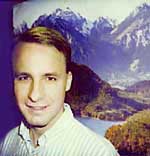At the University of Wisconsin’s program on Climate, People, and Environment, Dr. Jonathan Foley makes computer models to study what might happen if the human economy continues to emit greenhouse gases. Like hundreds of other climate scientists, he is deeply worried about global warming. Unlike most scientists I know, he carries that worry into his personal life.

Jonathan Foley, cool guy.
For some time, Jonathan and his wife Andrea and their three-year-old daughter Hannah have been cutting down the amount of carbon dioxide they produce — which means the amount of coal, oil, and gas they burn.
They used to live 25 miles out in the country and drive two cars. Now they’ve moved to a house four miles from the university with a bike lane at one end of the street and a bus line at the other. They’ve sold one car and rarely drive the other. “I was sick of all the driving anyway,” Foley says. “Now I have more time, a beautiful bike ride, and no car payments.”
The Foleys have done “all the usual things” to their house to reduce its fuel and electric needs. Compact fluorescent light bulbs. Much better insulation and ventilation. They found an electric utility that makes power with windmills, so they’re not contributing to climate change every time they flip on a switch. The house came fitted with a solar water-heating system, so the sun heats about two-thirds of their showers and dishwater, even in cold Wisconsin.
That is already climate responsibility well above the call of duty, but last New Year’s Eve, the Foleys decided to go all the way. They thought about the new millennium and decided to make a millennium-sized resolution to enter the 21st century emitting no net carbon dioxide.
How can you do that? I asked in disbelief.
Well, to start, Foley is compiling the numbers on how much carbon he emits with every mile he drives, every computer he buys, every plastic bag he throws away. He’s constructed a spreadsheet to calculate his carbon budget and to integrate it with his money budget, so his family will march toward zero carbon emissions one step at a time, as they can afford it.
“This month we’re trading in our electric washer and dryer for a more efficient front-load washer and a lot of clothesline. We’ll get a gas dryer for wintertime. Next, our goal is a more efficient refrigerator — the new domestic models are pretty good. The EPA Energy Star website lists all the alternatives.”
Foley aims first at high energy efficiency, then renewable sources. He expects there will be unavoidable carbon-dioxide emissions left, mainly embedded in things the family buys. He intends to offset those emissions with green plants that will absorb the carbon dioxide.
A group called American Forests, Foley tells me, has calculated that the average American would have to plant 30 new trees every year (and keep them all growing) to suck up the carbon dioxide he or she emits. There’s not enough room for us all to do that. But Foley figures he’s already cut his family’s emissions in half and can get down considerably further, to a point where he can pull off the necessary planting. Living in southern Wisconsin, he intends to plant not just trees, but prairie.
Every square meter of forest, Foley says, stores 10 to 15 kg of carbon in biomass above ground and 10 to 15 kg in the soil. A prairie stores only three kg above ground, but 30 to 40 below. Midwest soils are deep and fertile because the prairie built up humus there for millennia. Prairie restoration is a popular community activity around Madison, so the Foleys will help do the work and also contribute money to prairie and tree planting groups.
“It’s not all that hard,” Foley says. “Our quality of life has improved. We’re saving time and money, though some things, like the wind electricity, are more expensive. Zero carbon emissions is something anybody can do, just by making a few simple choices. People choose to spend tens of thousands of dollars for a sports utility vehicle with leather seats and a CD player. They could just as easily choose to buy better insulation or an efficient refrigerator or a solar water heater. Helping to prevent climate change isn’t a matter of our ability, just our choice. We’re not stuck. It’s not impossible.
“But whenever I talk about this stuff at scientific meetings, my colleagues look at me dumbfounded. We seem to think we should testify to Congress about the Kyoto Protocol and do nothing else. I’m surprised that other scientists aren’t more personally aware of their own actions. Airline travel to climate meetings is still my single largest emission of carbon dioxide — I’m counting work-related emissions in a separate budget. Isn’t it crazy that 100 scientists will fly to some remote place to discuss changes in the global carbon cycle?
“I know my personal actions are only a drop in the bucket (or in this case the atmosphere). But as a scientist and teacher I feel I have a moral obligation to lead, even in a small way, to show you can achieve a zero net carbon budget and still live comfortably and productively. Maybe if I set this kind of example, folks will begin to take the science I do a little more seriously.
“Something about putting your emissions where your mouth is.”

